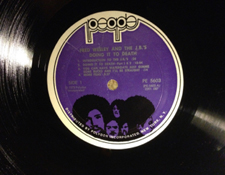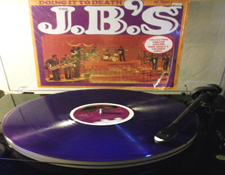It’s the time of year for saving money!
Out there in the wilds of record-collector, music-enthusiast audiophile-land, there is a wide gap between those who like their music as analogue-y as possible and those who don’t really care too much one way or another.
As long as it sounds good and is fairly true to the original pressings and original sound, most collectors are often happy with a reissue.
For the most part…
 Of course, within that group is a subset of collectors who turn up their nose at all manner of reissues, even if it comes from a respected high end audiophile company. They would rather pay premium coin for a deep groove original pressing from the 1950s or a so-called “hot stamper” edition that some are reselling these days. That’s cool. I get it.
Of course, within that group is a subset of collectors who turn up their nose at all manner of reissues, even if it comes from a respected high end audiophile company. They would rather pay premium coin for a deep groove original pressing from the 1950s or a so-called “hot stamper” edition that some are reselling these days. That’s cool. I get it.
Whatever floats your boat, right?
Part of the reason for this snootery amidst various and sundry collector-enthusiast types — and I think I just invented a word here folks …. snootery! — has to do with varying levels of mis-information, dis-information or simply non-information circulating on equally various and sundry audiophile forums and the like.
I do hope that — in my own little way — my humble writing is helping to clarify situations for you, Dear Readers. I relish those times when I have useful information at hand, or at least can shed some light on what to expect from those scenarios where we don’t have all the minutiae at our fingertips and and must rely solely on our eyes and ears to make a judgement call.
Now, in some ways, I myself have fallen prey to said “snootery,” springing $50 for a limited edition 200-gram blue vinyl reissue of a classic album like Miles Davis’ Kind Of Blue, for example. But even there, its hard to call that buy “snootery” as it was a purchase driven by a desire as near-definitive a version of the recording as possible at that time and place. My decision was driven by several factors including the facts that the reissue was (a) an expanded release with bonus tracks and (b) featuring a speed-corrected remaster that in theory would trump any original pressings and (c) would likely play cleaner with a quieter noise-floor than any original “six-eye” Columbia Records pressing I might find at a collectors shop.
I don’t regret that decision on minute — it sounds amazing.
Yet, I have also found myself on the flip-side of this scenario, opting for decent sounding bargain bin reissue simply because the cost-enjoyment ratio was just right. That is, my enjoyment of a $12 reissue might be just as high or higher than a $40 audiophile reissue simply because the variances between the pressings are (a) subtle and — for certain types of music — (b) almost irrelevant.
So what does this have to do with the vinyl shootout of a vintage 1973 James Brown side project related album?
Hang on a moment more…
These days, when you are out there looking for a vintage album on the collector’s marketplace, some can be very pricey due to relatively high levels of interest in the music genre and the artists involved. In the past five years, I’ve been digging in deeper to vintage Soul music from the 60s and 70s and I’ve learned this stuff can be hella pricey!
Hella pricey, ya hear!
 But seriously, old Soul albums were often played to death on less than perfect automatic record changers back in the day. Most everyone had one of those things back in the day and if they were a little out of alignment or the owners simply didn’t take care of their records, playing them in stacks (as many often did), well they just chewed up many records. Thus it is already a difficult thing to find nice good condition “clean” pressings out in the wild.
But seriously, old Soul albums were often played to death on less than perfect automatic record changers back in the day. Most everyone had one of those things back in the day and if they were a little out of alignment or the owners simply didn’t take care of their records, playing them in stacks (as many often did), well they just chewed up many records. Thus it is already a difficult thing to find nice good condition “clean” pressings out in the wild.
Add to that the modern day DJ culture which has inspired several generations of dance music DJ type collectors to snap up a lot of this stuff (including bringing a lot of it over for sale in Europe where so called “Northern Soul” is a big deal among the buying public). Soul records are more elusive than you would think and if you find an original pressing of something highly desirable, the albums can be costly.
This very long-winded intro is here to pave the way for a recent acquisition I made of one of these vintage Soul records that is indeed not easy to find (at a reasonable price): a clean copy of a vintage early 70s soul album by James Brown’s back up band The J.B.’s. called Doing it to Death on the boutique Polydor Records subsidiary label, People Records
The cool thing for you, Dear Readers, is that when I got the record home I remembered that I already had a budget-priced purple-colored vinyl reissue of this album which I picked up a year or so ago for $13 at Amoeba Records.
Bingo! I realized I could do another of my shoot out series of comparison / contrasts articles.
And that is what we’ll do here today….
]]>So when comparing these two albums, I technically couldn’t really do them side by side in A/B fashion. But I did the next best thing which involves playing one side and then switching albums to play the same side on the other disc. I did this several times, also doing some random needle drops to listen for any tell-tale artifacts or things jumping out at me.
 I played the album on a Music Hall MMF 7.1 turntable fitted with a Goldring 2400 cartridge, playing through a Bellari tube preamp fed into a nice older Denon AVR (Model 3802) and listening over a pair of JBL 4410A studio monitors.
I played the album on a Music Hall MMF 7.1 turntable fitted with a Goldring 2400 cartridge, playing through a Bellari tube preamp fed into a nice older Denon AVR (Model 3802) and listening over a pair of JBL 4410A studio monitors.
After a few back-and-forths like this I was able to hear the distinct sonic footprints between these different pressings. And I’ll now cut to the chase and say that for the $13 I paid for the purple vinyl reissue, it sounds pretty darn good! The reissue vinyl is quiet and well centered. Mine does have a bit of rollercoaster warp action going on, alas, but that doesn’t seem to be affecting the sound of the music.
That said, the purple vinyl is a bit louder than the original pressing. If you look at the run off grooves, you’ll see that the reissue has almost no run off groove! While on one hand that might seem a good thing — wider grooves and such in theory –there might technically be a bit more distortion on the innermost grooves due to the tighter tracking angle. But again, given the nature of this music which is basically a bunch of fun extended jams with a then-uncredited James Brown leading the band (he is singing through much of it) I wonder if any of that detail matter too much. Perhaps, if this were a two-disc 45 RPM set we were comparing to the original it might well, but as it stands this detail might be considered splitting hairs.
Now, I have absolutely no idea what source this new purple vinyl pressing was made from but it does hold up pretty well in comparison to the original pressing. The original pressing has more warmth and presence about it. It is missing that sort of sonic footprint I was talking about earlier which I suspect is some sort of artifact from digital processing somewhere along the way in the making of the reissue. It is more noticeable as you turn up the volume too, but its not the kind of super harsh digitally processed sound that I find painful to the ears But I do hear it coming across in the form of slightly more phase-y sounding ride cymbals and other high end instrumentation. I particularly picked it up on the jazzy side two jam tune called “Sucker.”
Nonetheless, this reissue still can shake some booty.
 In a way, the $13 reissue wins out over the original in that the noise floor is quieter than the original pressing — remember, early/mid 70s pressings were notorious for noise due to the oil crisis and corners being cut by the manufacturers, including use of cheaper vinyl and even sometimes recycled vinyl.
In a way, the $13 reissue wins out over the original in that the noise floor is quieter than the original pressing — remember, early/mid 70s pressings were notorious for noise due to the oil crisis and corners being cut by the manufacturers, including use of cheaper vinyl and even sometimes recycled vinyl.
All that said, I personally like the way the horns and cymbals sound on the original; I like that it doesn’t have that phase-y thing going on in the high end.
But at the end of the day its a very subtle difference and if you just want to hear these great grooves, the purple reissue will probably suit your needs just fine.
So there you have it: old vinyl vs. new. Take your pick!






